Inside The New York Botanical Garden
Esther Jackson
Posted in From the Library on July 19 2017, by Esther Jackson
Esther Jackson is the Public Services Librarian at NYBG’s LuEsther T. Mertz Library where she manages Reference and Circulation services and oversees the Plant Information Office. She spends much of her time assisting researchers, providing instruction related to library resources, and collaborating with NYBG staff on various projects related to Garden initiatives and events.
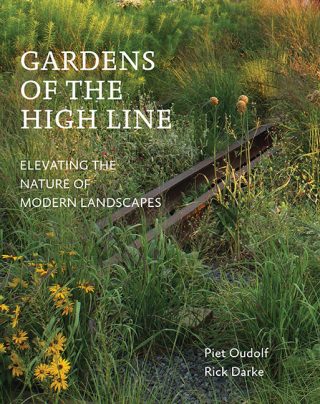 The High Line, “a public park built on a historic freight rail line elevated above the streets on Manhattan’s West Side,” is a popular NYC attraction for locals and tourists alike. Before reading Gardens of the High Line: Elevating the Nature of Modern Landscapes by Piet Oudolf and Rick Darke, I had the benefit of reading a wonderful review of the book written by Patricia Jonas for the Council on Botanical and Horticultural Libraries Newsletter. In her review, after a summary of the many books published on the High Line garden over the past six years, Jonas writes, “Could there possibly be any more vital books about the High Line yet to be published? Well, yes. Gardens of the High Line is the icing on all of this publishing and the only book to focus exclusively on the famous park’s planting design and the plants.”
The High Line, “a public park built on a historic freight rail line elevated above the streets on Manhattan’s West Side,” is a popular NYC attraction for locals and tourists alike. Before reading Gardens of the High Line: Elevating the Nature of Modern Landscapes by Piet Oudolf and Rick Darke, I had the benefit of reading a wonderful review of the book written by Patricia Jonas for the Council on Botanical and Horticultural Libraries Newsletter. In her review, after a summary of the many books published on the High Line garden over the past six years, Jonas writes, “Could there possibly be any more vital books about the High Line yet to be published? Well, yes. Gardens of the High Line is the icing on all of this publishing and the only book to focus exclusively on the famous park’s planting design and the plants.”
Gardens of the High Line is exquisite, and a treat for regular High Line visitors and those who can only admire the space from afar. In the book’s introduction, Friends of the Highline co-founder Robert Hammond writes, “when I first stepped up on the High Line in 1999, I truly fell in love. What I fell in love with was the tension. It was there in the juxtaposition between the hard and the soft, the wild grasses and billboards, the industrial relics and natural landscape, the views of both wildflowers and the Empire State Building. It was ugly and beautiful at the same time. And it’s that tension that gives the High Line its power.” This tension is captured in the photographs of Gardens of the High Line, although Lorraine Ferguson’s graphic design of the volume makes even the most “ugly” portraits of the space seem beautiful.
Less focused on the history of the space and more concerned with the gardens themselves, Gardens of the Highline is a plant lover’s dream. Each of the High Line’s 13 gardens are profiled and described with extensive photographs, including wonderful aerial photographs. These aerial shots, in particular, offer a new glimpse into this popular site’s overarching design ethos.
It’s unlikely that you’ll ever find the High Line as contemplative and empty as it appears in many of the Gardens of the High Lines photographs, but the book reminds readers why this dynamic space is so special and so worth returning to again and again throughout the seasons and years.
Posted in From the Library on July 5 2017, by Esther Jackson
Esther Jackson is the Public Services Librarian at NYBG’s LuEsther T. Mertz Library where she manages Reference and Circulation services and oversees the Plant Information Office. She spends much of her time assisting researchers, providing instruction related to library resources, and collaborating with NYBG staff on various projects related to Garden initiatives and events.
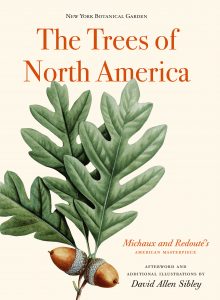 The Trees of North America: Michaux and Redouté’s American Masterpiece is a new book from The New York Botanical Garden and Abbeville Press. This beautiful volume includes 277 color plates from The North American Sylva, the first volumes of which were published in 1817 by François André Michaux (1770–1855), followed by subsequent volumes in the 1840s by Thomas Nuttall (1786–1859).
The Trees of North America: Michaux and Redouté’s American Masterpiece is a new book from The New York Botanical Garden and Abbeville Press. This beautiful volume includes 277 color plates from The North American Sylva, the first volumes of which were published in 1817 by François André Michaux (1770–1855), followed by subsequent volumes in the 1840s by Thomas Nuttall (1786–1859).
François André Michaux was a French botanist and explorer. François André with his father, Andre? Michaux (1746–1802), wrote some of the most important and widely-read books about North American flora. Susan Fraser (Vice President and Director of the LuEsther T. Mertz Library) and author Marta McDowell have written detailed introductory essays in The Trees of North America which include bibliographic information about the series and biographical information about the two Michaux explorers and Thomas Nuttall, the author who eventually completed the project.
It’s impossible to look at these plates without thinking about the early days of botany as we know it in North America. For those who love native trees, The Trees of North America is both beautiful and transportive. Certain plates, such as that of Castanea dentata, the American chestnut, are lovely and bittersweet. With accompanying illustrations by David Allen Sibley (who also wrote the afterword), The Trees of North America is an enjoyable read for all history of science and native plant enthusiasts.
Posted in From the Library on June 20 2017, by Esther Jackson
Esther Jackson is the Public Services Librarian at NYBG’s LuEsther T. Mertz Library where she manages Reference and Circulation services and oversees the Plant Information Office. She spends much of her time assisting researchers, providing instruction related to library resources, and collaborating with NYBG staff on various projects related to Garden initiatives and events.
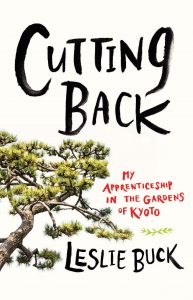 Cutting Back: My Apprenticeship in the Gardens of Kyoto by Leslie Buck is part memoir, part travelogue, and part garden design narrative. In 1999, Buck, then the owner of a pruning business in California, traveled to Japan in pursuit of an internship. Having worked with Japanese and Japanese-taught mentors previously, Buck was determined to gain additional training from Japanese craftspeople working in Japan’s famed gardens. Through the help of contacts in Kyoto, Buck obtained an internship at Uetoh Zoen, one of the oldest and most respected landscape companies in Kyoto.
Cutting Back: My Apprenticeship in the Gardens of Kyoto by Leslie Buck is part memoir, part travelogue, and part garden design narrative. In 1999, Buck, then the owner of a pruning business in California, traveled to Japan in pursuit of an internship. Having worked with Japanese and Japanese-taught mentors previously, Buck was determined to gain additional training from Japanese craftspeople working in Japan’s famed gardens. Through the help of contacts in Kyoto, Buck obtained an internship at Uetoh Zoen, one of the oldest and most respected landscape companies in Kyoto.
For the most part, it was interesting to read about Buck’s experience working on a pruning-only garden crew, as well as to learn about her attempts to understand and navigate Japanese culture as an American woman. Buck wrote that her “Bossman” was constantly challenging her with progressively more difficult tasks, and for that reason she never fully settled in to her internship or hit her stride. By the end of the book, Buck seemed to have learned about Japanese work ethic, culture, and gardening practices in spite of forgetting all the Japanese language she had learned (as she claimed).
Read More
Posted in From the Library on June 20 2017, by Esther Jackson
Esther Jackson is the Public Services Librarian at NYBG’s LuEsther T. Mertz Library where she manages Reference and Circulation services and oversees the Plant Information Office. She spends much of her time assisting researchers, providing instruction related to library resources, and collaborating with NYBG staff on various projects related to Garden initiatives and events.
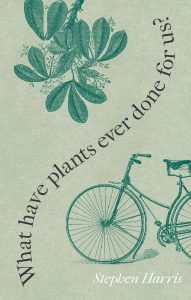 What Have Plants Ever Done for Us? is a wonderful book about botany, history, and human society. Authored by Stephen Harris, Curator of the Oxford University Herbaria and a University Research Lecturer, Plants was published in 2015. Those who read a lot of popular science books about botany will be aware that there are quite a few books published in the vein of Plants, sort of “natural history prose” about how certain plant species or plant groups have been used by humans throughout the ages.
What Have Plants Ever Done for Us? is a wonderful book about botany, history, and human society. Authored by Stephen Harris, Curator of the Oxford University Herbaria and a University Research Lecturer, Plants was published in 2015. Those who read a lot of popular science books about botany will be aware that there are quite a few books published in the vein of Plants, sort of “natural history prose” about how certain plant species or plant groups have been used by humans throughout the ages.
Poorly-researched books are a dime a dozen, which makes Plants all the more wonderful. Harris is a detail-oriented researcher who writes well, both clearly and with a very dry (sometimes hard to catch) sense of humor. Not only does Harris review and condense several more recent “a history of” publications about different plants (for example, The Pineapple: The King of Fruits or Tobacco: A Cultural History of How an Exotic Plant Seduced Civilization), he incorporates recent scholarly scientific research articles as well as notable historic works written between the 15th and 20th centuries. Harris deftly weaves his narrative with elements of history, botanical nomenclature, taxonomy, plant morphology, genetic research, and economics. In addition to very good scientific writing, there is a great deal here about the trade and colonization practices of European powers in particular, as well as elements of conservation theory.
Any lover of plants will enjoy What Have Plants Ever Done for Us?. Readers can sample a chapter or two at a time, or read the text from cover to cover. Teachers in many different disciplines—humanities and sciences both—might also find Plants to be very valuable as a teaching aid, either by assigning chapters to students as readings or using chapter topics to structure lesson plans. Having finished Plants, I am now eager to read more by Harris! In particular, Oxford Botanic Garden & Arboretum: A Brief History, Harris’s new book from University of Chicago Press.
Posted in From the Library on June 1 2017, by Esther Jackson
Esther Jackson is the Public Services Librarian at NYBG’s LuEsther T. Mertz Library where she manages Reference and Circulation services and oversees the Plant Information Office. She spends much of her time assisting researchers, providing instruction related to library resources, and collaborating with NYBG staff on various projects related to Garden initiatives and events.
 Medical marijuana is a hot topic in many parts of the United States. In New York, the use of medical marijuana has been approved for the treatment of symptoms of various diseases and conditions. Those wishing to learn more about medical marijuana should consider attending NYBG’s Adult Education Medical Cannabis class which will likely be offered in the fall of this year.
Medical marijuana is a hot topic in many parts of the United States. In New York, the use of medical marijuana has been approved for the treatment of symptoms of various diseases and conditions. Those wishing to learn more about medical marijuana should consider attending NYBG’s Adult Education Medical Cannabis class which will likely be offered in the fall of this year.
While it is not legal to grow marijuana in New York, the books below offer insight into marijuana culture and history, as well as information about how marijuana is cultivated legally by those in states that permit such practices.
Smoke Signals: A Social History of Marijuana—Medical, Recreational and Scientific by Martin A. Lee chronicles the history of marijuana in America. Lee is not the first author to write a history of Cannabis sativa, but the social history focus of this book is especially interesting for readers who want to know the legal aspects of marijuana criminalization, regulation, and legislation in the United States. In addition, the author also explores contemporary medical research around using marijuana to treat conditions including cancer, heart disease, Alzheimer’s, diabetes, and chronic pain. Lee, a journalist, is skilled at drawing the reader in and also does the more motivated researcher the service of providing an extensive bibliography for further reading.
Read More
Posted in From the Library on May 15 2017, by Esther Jackson
Esther Jackson is the Public Services Librarian at NYBG’s LuEsther T. Mertz Library where she manages Reference and Circulation services and oversees the Plant Information Office. She spends much of her time assisting researchers, providing instruction related to library resources, and collaborating with NYBG staff on various projects related to Garden initiatives and events.
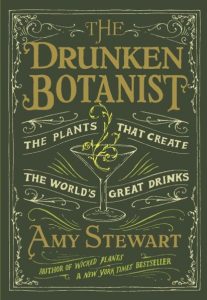 This week we dive into a few books detailing the rich history of botanical spirits, and the ways in which we’ve called on the garden to supply us with our favorite tipples.
This week we dive into a few books detailing the rich history of botanical spirits, and the ways in which we’ve called on the garden to supply us with our favorite tipples.
The Drunken Botanist: The Plants That Create the World’s Great Drinks by Amy Stewart is a treat from start to finish. Drunken Botanist follows Wicked Plants and Wicked Bugs, two excellent books about organisms that can be dangerous to humans. (Read my review of Wicked Plants here.) Stewart is a talented writer, a careful historian, an excellent amateur botanist, and a skilled bartender. Drunken Botanist follows the format of her earlier books, with Stewart selecting different plants and offering readers narratives about their nativity and the history of their usage by humans—specifically how and when they were used to make alcoholic drinks. Sake, scotch, rum, tequila, bourbon, and their plant parents are just a few of the drinks that are featured. Stewart writes, “It would be impossible to describe every plant that has ever flavored an alcoholic beverage. I am certain at this very moment, a craft distiller in Brooklyn is plucking a weed from a crack in the sidewalk and wondering if it would make a good flavoring for a new line of bitters.” Before plucking sidewalk weeds, craft distiller and home bartenders alike would do well to look to Drunken Botanist for inspiration, “stirring” stories, and an infectious excitement about plants that is one of Stewart’s enduring trademarks.
Read More
Posted in From the Library on May 8 2017, by Esther Jackson
Esther Jackson is the Public Services Librarian at NYBG’s LuEsther T. Mertz Library where she manages Reference and Circulation services and oversees the Plant Information Office. She spends much of her time assisting researchers, providing instruction related to library resources, and collaborating with NYBG staff on various projects related to Garden initiatives and events.
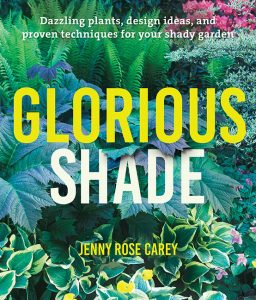 Glorious Shade from Jenny Rose Carey and Timber Press is a lovely meditation on shade gardening. Carey, the senior director at the Pennsylvania Horticultural Society’s Meadowbrook Farm, is a talented writer and photographer, and she frames her book as a conversation about shade gardening. After an introduction detailing different kinds of shade, the narrative ambles through different topics related to shade gardening, culminating in an extensive and beautifully photographed plant palette. Chapter titles include “Shades of Shade: Observing Shifting Patterns in Your Garden,” “The Gardener’s Calendar: Seasonal Changes in the Shade Garden,” “Down and Dirty: The Intertwined, Underground World of Soil and Roots,” “Planting for Success: Techniques and Maintenance,” “Designing in the Shadows: Bright Ideas of Shady Spaces,” and “The Plant Palette: Choosing Plants for Your Shade Garden.”
Glorious Shade from Jenny Rose Carey and Timber Press is a lovely meditation on shade gardening. Carey, the senior director at the Pennsylvania Horticultural Society’s Meadowbrook Farm, is a talented writer and photographer, and she frames her book as a conversation about shade gardening. After an introduction detailing different kinds of shade, the narrative ambles through different topics related to shade gardening, culminating in an extensive and beautifully photographed plant palette. Chapter titles include “Shades of Shade: Observing Shifting Patterns in Your Garden,” “The Gardener’s Calendar: Seasonal Changes in the Shade Garden,” “Down and Dirty: The Intertwined, Underground World of Soil and Roots,” “Planting for Success: Techniques and Maintenance,” “Designing in the Shadows: Bright Ideas of Shady Spaces,” and “The Plant Palette: Choosing Plants for Your Shade Garden.”
Carey touches on a variety of topics, and the more unique parts of her book relate to shade plants with specific seasonal interest, suggestions of appropriate under-plantings for specific trees, and, of course, her wonderful plant palette. In terms of practical advice about garden installation and design, the book is a bit too general for either a beginner or an expert. However, in all, Glorious Shade is an excellent reference for gardeners working with shaded areas who are looking for inspiration in terms of garden design and new plants to trial. For those who simply love beautiful garden books, Glorious Shade is also appropriate, as Carey’s photographs are lovely and the book’s visual design is excellent.
Read More
Posted in From the Library on May 1 2017, by Esther Jackson
Esther Jackson is the Public Services Librarian at NYBG’s LuEsther T. Mertz Library where she manages Reference and Circulation services and oversees the Plant Information Office. She spends much of her time assisting researchers, providing instruction related to library resources, and collaborating with NYBG staff on various projects related to Garden initiatives and events.
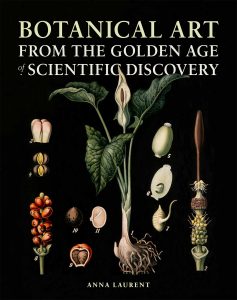 Botanical Art from the Golden Age of Scientific Discovery was one of my Top 10 Popular Science Books of 2016. As I wrote in my earlier review, author Anna Laurent has curated an exquisite collection of historic botanical art. “More than an archive of illustrations and inquiry, this book documents an extraordinary convergence of disciplines that flourished in the late nineteenth and early twentieth centuries,” she writes. “Europe was enjoying a golden age of scientific discovery; naturalists were exploring the globe and there was a clamoring for knowledge of the natural world.”
Botanical Art from the Golden Age of Scientific Discovery was one of my Top 10 Popular Science Books of 2016. As I wrote in my earlier review, author Anna Laurent has curated an exquisite collection of historic botanical art. “More than an archive of illustrations and inquiry, this book documents an extraordinary convergence of disciplines that flourished in the late nineteenth and early twentieth centuries,” she writes. “Europe was enjoying a golden age of scientific discovery; naturalists were exploring the globe and there was a clamoring for knowledge of the natural world.”
The art in this book comes specifically from botanical wall charts. These charts were created as teaching tools during the 19th and 20th centuries. Produced by professors, biologists, illustrators, writers, and botanists, wall charts were used in classroom instruction to supplement lessons involving living or vouchered plants. These wall charts were first documented in Germany in the 1820s. In addition to featuring many beautiful German charts, the book includes examples of charts from various countries.
Read More
Posted in From the Library on April 21 2017, by Esther Jackson
Esther Jackson is the Public Services Librarian at NYBG’s LuEsther T. Mertz Library where she manages Reference and Circulation services and oversees the Plant Information Office. She spends much of her time assisting researchers, providing instruction related to library resources, and collaborating with NYBG staff on various projects related to Garden initiatives and events.
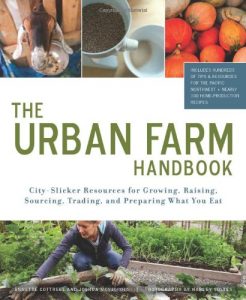 The Urban Farm Handbook: City-Slicker Resources for Growing, Raising, Sourcing, Trading, and Preparing What You Eat is a 2011 book by Annette Cottrell and Joshua McNichols for Skipstone. The word “handbook” is frequently applied to a variety of books, some useful and some less useful. “Handbook,” in the case of Urban Farm Handbook, is appropriately used, as Cottrell and McNicols provide readers with hundreds of tips and resources for every aspiring and current urban homesteader.
The Urban Farm Handbook: City-Slicker Resources for Growing, Raising, Sourcing, Trading, and Preparing What You Eat is a 2011 book by Annette Cottrell and Joshua McNichols for Skipstone. The word “handbook” is frequently applied to a variety of books, some useful and some less useful. “Handbook,” in the case of Urban Farm Handbook, is appropriately used, as Cottrell and McNicols provide readers with hundreds of tips and resources for every aspiring and current urban homesteader.
Handbook is divided into four seasons. Each season includes suggested seasonal chores related to food, both plant and animal. Do you want to keep chickens for eggs? Plant a vegetable garden? Learn home food preservation? Raise and slaughter rabbits for meat? All this and more is discussed in the Handbook. Readers can jump into a chapter to learn about a single topic, or read the book from cover to cover and get the tools for undergoing a radical lifestyle change.
Read More
Posted in From the Library on April 14 2017, by Esther Jackson
Esther Jackson is the Public Services Librarian at NYBG’s LuEsther T. Mertz Library where she manages Reference and Circulation services and oversees the Plant Information Office. She spends much of her time assisting researchers, providing instruction related to library resources, and collaborating with NYBG staff on various projects related to Garden initiatives and events.
 The Foodscape Revolution: Finding a Better Way to Make Space for Food and Beauty in Your Garden is a new book by Brie Arthur for St. Lynn’s Press. This charming and accessible book offers guidance for new gardeners and inspiration for the more experienced.
The Foodscape Revolution: Finding a Better Way to Make Space for Food and Beauty in Your Garden is a new book by Brie Arthur for St. Lynn’s Press. This charming and accessible book offers guidance for new gardeners and inspiration for the more experienced.
From the first page, Arthur draws the readers in with a friendly, assuring, and easy tone. She writes for people who want to grow edible plants and also for those who have a love for ornamentals. As such, she advocates for “foodscaping,” or growing food alongside flowers in a landscape that already exists. By mixing annual vegetables with perennial ornamentals (or other combinations), home gardeners can have access to delicious and organic produce without sacrificing the ornamentals they love.
Read More
 The High Line, “a public park built on a historic freight rail line elevated above the streets on Manhattan’s West Side,” is a popular NYC attraction for locals and tourists alike. Before reading Gardens of the High Line: Elevating the Nature of Modern Landscapes by Piet Oudolf and Rick Darke, I had the benefit of reading a wonderful review of the book written by Patricia Jonas for the Council on Botanical and Horticultural Libraries Newsletter. In her review, after a summary of the many books published on the High Line garden over the past six years, Jonas writes, “Could there possibly be any more vital books about the High Line yet to be published? Well, yes. Gardens of the High Line is the icing on all of this publishing and the only book to focus exclusively on the famous park’s planting design and the plants.”
The High Line, “a public park built on a historic freight rail line elevated above the streets on Manhattan’s West Side,” is a popular NYC attraction for locals and tourists alike. Before reading Gardens of the High Line: Elevating the Nature of Modern Landscapes by Piet Oudolf and Rick Darke, I had the benefit of reading a wonderful review of the book written by Patricia Jonas for the Council on Botanical and Horticultural Libraries Newsletter. In her review, after a summary of the many books published on the High Line garden over the past six years, Jonas writes, “Could there possibly be any more vital books about the High Line yet to be published? Well, yes. Gardens of the High Line is the icing on all of this publishing and the only book to focus exclusively on the famous park’s planting design and the plants.” 








